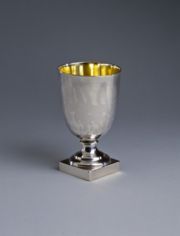Silver Goblets
Artist/Maker: Claude-Nicolas Delanoy (active 1766-c. 1793); designed by Thomas Jefferson
Created: 1789
Origin/Purchase: Paris
Materials: silver with gilt interior
Dimensions: (1) H: 11.7 (4 5/8 in.); D (rim): 7.5 (2 15/16 in.); Base: 5.1 (2 in.) square Wt: 227.5 g (7 oz. 6 dwt. 7 gr.); (2) H: 12.4 (4 7/8 in.): D (rim): 7.6 (3 in.); Base: 5.1 (2 in.) square Wt: 218.6 g (7 oz. 13 gr.)
Location: Dining Room
Provenance: Thomas Jefferson; by descent to Elizabeth Martin Randolph, widow of Meriwether Lewis Randolph; by gift to Bettie M. Donelson; by purchase to Mr. and Mrs. Stanley Horn; by descent to Stanley F. Horn, Jr. and Ruth Crownover; by purchase to the Thomas Jefferson Foundation in 1982
Accession Number: 1982-33
Historical Notes: On June 3, 1789, Jefferson recorded in his memorandum book the sum of 229 livres paid for a "pr. goblets &c."[1] Jefferson made his purchase at the shop of Odiot on the rue St. Honoré in Paris. On an invoice from Odiot dated that same day, Jefferson bought a silver coffee urn, a present for the architect Clerisseau, and "Deux Goblet, Pareille au Model." The silver for the two goblets cost 109 livres. Sixty livres was charged for labor, plus some other small amounts, including 36 livres for gilding the interior of the bowls. The goblets made "like the model" are based on a Jefferson drawing that shows three goblets of varying proportions.[2] The silver goblets differ slightly from Jefferson's drawing in the shape of their bowls; they differ from each other in size and particularly in stem shape. They are distinctive for their unembellished surfaces and architectural form, quite unlike other contemporary examples of French silver cups. Timbales, or beakers with no stem, typically had much gadrooning and other decoration.
Both goblets bear the Paris guild mark used from November 1788 to September 1789, charge and discharge marks, and the mark of the maker, Claude-Nicolas Delanoy. Delanoy, born about 1735, became a master silversmith in 1766 and was listed at six different addresses between 1783 and 1793, including the rue Neuve St. Méderic where he was working in 1789.[3] Nothing is known about his relationship with Odiot, but it seems likely that Odiot assigned Jefferson's commission, a relatively small job, to the capable but lesser-known master.
In September 1789 Jefferson returned to the United States; the two "silver and vermeil goblets" were shipped with his other belongings the following year.[4] At Monticello, during the years of Jefferson's retirement, they were used at table with the set of eight silver tumblers made by John Letelier in 1810. Jefferson included "10 Silver Cups" on his 1815 list of taxable property.[5] These were undoubtedly the "8 becars, 2 goblets" specified on Martha Jefferson Randolph's silver inventory of about 1823.[6]
After Jefferson's death, the family silver was taken to the Randolph home, Edgehill. In 1837, the year after Martha Jefferson Randolph's death, her eldest son received news of his brother Meriwether Lewis Randolph's death. He wrote to the widowed Mrs. Randolph:
The morning of the day on which we received the afflicting intelligence we had divided the family plate between my brothers. Of itself not of much value to him, it would have been valuable from association. You will direct what shall be done with his share.[7]
The pair of silver goblets were among the items sent to Elizabeth Martin Randolph in Tennessee.
- Text from Stein, Worlds, 327
References
- ^ Jefferson, June 3, 1789, in MB, 1:734-35. Transcription available at Founders Online.
- ^ Jefferson, drawing of three goblets, c.1789, Coolidge Collection of Thomas Jefferson Manuscripts, Massachusetts Historical Society.
- ^ Henry Nocq, Le Poinçon de Paris: Répertoire des Maîtres-orfèvres de la Juridiction de Paris Depuis le Moyen-age Jusqu'à la Fin du XVIII Siècle (Paris: Léonce Laget, 1968), 1:48.
- ^ Grevin packing list, July 17, 1790, William Short Papers, Library of Congress. See also Short to Jefferson, November 7, 1790, in PTJ, 18:30-39n. The accompanying editorial note, available at Founders Online, includes extensive data on the 86 crates packed by Grevin.
- ^ Jefferson’s Statement of Albemarle County Property Subject to State Tax, March 1815, in PTJ, 8:392-94. Transcription available at Founders Online.
- ^ Martha Jefferson Randolph, housewife list, c. 1823, Thomas Jefferson Foundation, Inc.
- ^ Thomas Jefferson Randolph to Elizabeth Martin Randolph, December 25, 1837, Edgehill-Randolph Papers, Special Collections, University of Virginia Library.
